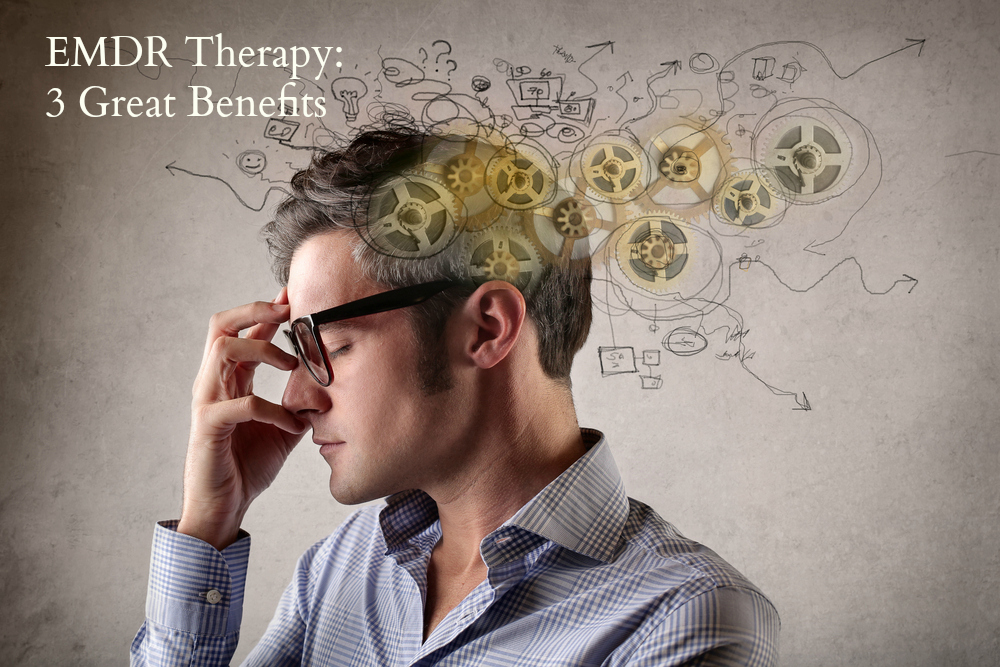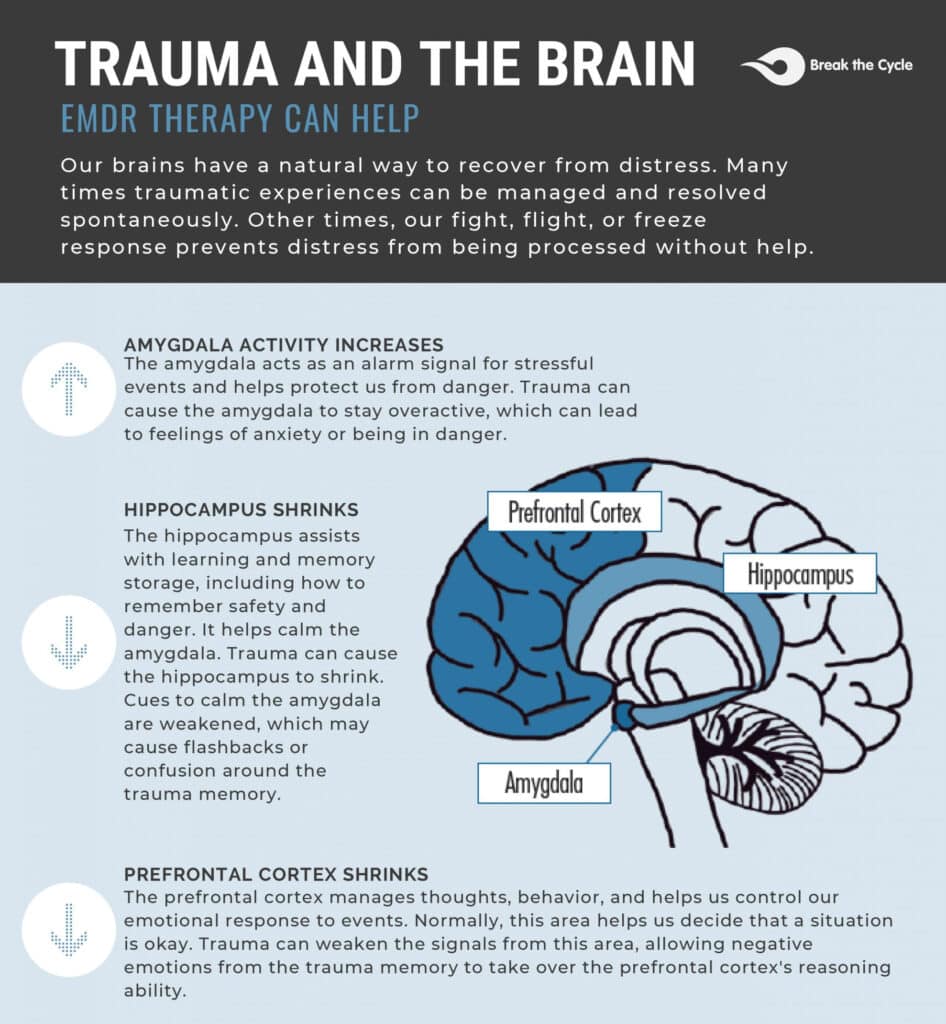EMDR therapy explained for patients wanting recovery
Wiki Article
The Refine of EMDR Treatment: a Comprehensive Guide to Its Advantages and methods
EMDR therapy stands apart as a structured approach for dealing with stressful memories. Its multi-phase method and incorporation of bilateral stimulation strategies established it in addition to typical treatments. By promoting the reprocessing of traumatic experiences, EMDR supplies an one-of-a-kind path to healing. What particular techniques are employed, and what benefits do they give injury recovery? Exploring these facets discloses a deeper understanding of this effective healing alternative.Comprehending EMDR Therapy: An Overview
EMDR treatment, or Eye Motion Desensitization and Reprocessing, is a psychotherapy approach made to relieve the distress connected with terrible memories. Developed by Francine Shapiro in the late 1980s, EMDR incorporates aspects from various healing techniques, consisting of cognitive-behavioral therapy and psychodynamic treatment. The primary objective of EMDR is to help individuals procedure and reframe traumatic memories, decreasing their emotional cost and connected symptoms.Throughout EMDR sessions, customers take part in double attention stimulations, normally involving led eye motions, while remembering stressful memories - emdr therapy new york city. This process enables the mind to reprocess the memory in a much healthier fashion. EMDR has gained acknowledgment for its effectiveness in dealing with PTSD, stress and anxiety, and clinical depression, among various other conditions. Research has actually revealed that EMDR can lead to considerable improvements in emotional wellness. As an organized intervention, it supplies a complete framework for therapists to assist clients in getting rid of the influence of previous injuries
The Eight Phases of EMDR
While numerous restorative approaches vary in structure and method, the eight phases of EMDR supply an organized framework that guides the restorative procedure. These stages begin with the history-taking and therapy planning, where the specialist gathers appropriate information about the client's experiences and establishes a safe environment. The second phase concentrates on prep work, gearing up clients with tools to manage psychological distress.In the 3rd stage, customers recognize details memories to target. The 4th stage entails desensitization, where customers refine these memories while taking part in reciprocal excitement. The 5th stage stresses setup, reinforcing positive ideas. The 6th stage addresses body scan techniques to identify any kind of recurring stress.
The final two phases involve closure, returning customers to a state of stability, and reevaluation, reviewing the performance of the treatment. This structured approach warranties that EMDR treatment is thorough, addressing both the emotional and physical aspects of injury.
Secret Techniques Used in EMDR Procedure
In EMDR sessions, therapists make use of certain methods to help with recovery and processing of terrible memories. Key among these are bilateral excitement methods, which engage both hemispheres of the brain, and numerous memory processing strategies that aid customers reframe their experiences. Comprehending these techniques is important for grasping the efficiency of EMDR treatment.Reciprocal Stimulation Methods
Bilateral excitement techniques are essential methods employed throughout EMDR sessions to help with the handling of traumatic memories. These techniques entail engaging both hemispheres of the brain, advertising integration and recovery. Usual bilateral excitement techniques consist of auditory cues, such as alternating tones or audios, and responsive stimulation, with using handheld gadgets that develop alternating taps. Aesthetic stimulations, such as the therapist assisting the customer's eye movements back and forth, are also commonly made use of. The rhythmic nature of these methods aids to activate the mind's natural handling capacities, enabling clients to recycle stressful memories in a secure atmosphere. Ultimately, reciprocal stimulation cultivates a sense of security and improves the restorative experience throughout EMDR.Memory Handling Strategies
Memory handling techniques in EMDR sessions are critical for assisting customers face and revamp stressful experiences. These techniques concentrate on assisting in the reprocessing of traumatic memories, permitting customers to incorporate and fix adverse feelings connected with them. One trick approach entails using reciprocal stimulation, which can consist of tactile sensations or auditory tones, to enhance the brain's info processing capabilities. During sessions, clients are guided to remember specific memories while concurrently participating in bilateral stimulation, advertising a double focus on the existing moment and the terrible memory. This method aids in reducing the psychological fee of the memory, making it less intrusive. Inevitably, memory handling techniques empower customers to rebuild their narratives, cultivating recovery and resilience.The Duty of Bilateral Excitement
Reciprocal stimulation is an essential part of EMDR therapy, facilitating the handling of stressful memories. Different methods, such as auditory, tactile, and visual excitement, are used to engage both hemispheres of the mind. This technique has been shown to improve trauma recuperation by advertising emotional policy and reducing distress connected with previous experiences.Mechanism of Reciprocal Excitement
The device of reciprocal stimulation plays a vital duty in assisting in the processing of distressing memories when people engage in EMDR treatment. This strategy involves alternating excitement, usually via auditory, tactile, or aesthetic methods, which triggers both hemispheres of the brain. The rhythmic nature of bilateral excitement is thought to simulate the mind's natural processing mechanisms during rapid eye movement, promoting assimilation of upsetting memories. As customers concentrate on their traumatic experiences while concurrently participating in this stimulation, they may experience a reduction in emotional fee linked with those memories. Consequently, this process enables for the reprocessing of injury, leading to enhanced psychological law and a more adaptive viewpoint on past occasions.Sorts Of Stimulation Strategies
Numerous stimulation techniques are made use of in EMDR treatment to improve the reprocessing of distressing memories. The main approach is reciprocal stimulation, that includes auditory, aesthetic, and tactile modalities. Acoustic stimulation usually entails rotating audios played via earphones, while visual stimulation can consist of assisted eye motions from side to side. Tactile excitement might make use of portable devices that develop rotating taps on the customer's hands. Each of these methods aims to involve both hemispheres of the brain, helping with a more effective handling of distressing memories. Specialists may pick one or a combination of these techniques based on customer preferences and restorative goals, making certain a tailored method to official website recovery. These techniques are essential for advertising a deeper combination of traumatic experiences within the healing framework.Advantages for Trauma Recovery
The function of reciprocal stimulation in EMDR therapy considerably adds to trauma recuperation by helping with the handling of upsetting memories. This method involves alternating sensory input, generally via eye movements or acoustic tones, which assists in integrating distressing experiences. By involving both hemispheres of the brain, bilateral excitement boosts emotional guideline and reduces the intensity of stressful memories. Research indicates that customers typically experience a decrease in anxiousness and an enhanced capacity to confront upsetting thoughts. In addition, this method advertises cognitive adaptability, allowing individuals to reframe their experiences in a much more adaptive way. Inevitably, the usage of reciprocal excitement in EMDR treatment plays a necessary duty in making it possible for people to attain lasting recovery and durability when faced with trauma.The Science Behind EMDR: Exactly How It Works
Although the precise systems of Eye Activity Desensitization and Reprocessing (EMDR) treatment are still being discovered, study suggests that it helps with the processing of terrible memories by integrating sensory, emotional, and cognitive components. EMDR uses reciprocal excitement, commonly via assisted eye motions, which is believed to mimic the mind's all-natural processing during REM rest. his explanation This stimulation might assist clients access and recycle traumatic memories, minimizing their emotional charge.Neuroscientific researches suggest that EMDR may modify the way distressing memories are stored in the mind, promoting adaptive resolution. The treatment encourages people to face their memories and linked ideas, allowing them to reframe their experiences. On top of that, the structured stages of EMDR-- such as desensitization, history-taking, and setup-- support a complete exploration of the injury, fostering assimilation of the fragmented elements of the memory. This process inevitably aims to restore a feeling of equilibrium and emotional wellness.
Benefits of EMDR for Injury Recuperation
EMDR treatment uses many benefits for people recovering from injury, especially by resolving the cognitive and emotional distortions associated with distressing experiences. One significant advantage is its capability to promote rapid handling of traumatic memories, commonly leading to a reduction in signs and symptoms such as stress and anxiety and depression. This technique enables customers to confront their trauma in a structured and secure environment, promoting strength and psychological guideline.Additionally, EMDR assists people reframe negative beliefs connected to their trauma, advertising a healthier self-image and bring back a sense of control. The treatment can boost overall psychological well-being and equip customers to reclaim their lives, making it a valuable tool in trauma healing. In addition, EMDR is suitable for different age teams and can be adapted to satisfy the details needs of individuals, making it a flexible option for those seeking to heal from their terrible experiences successfully.
Who Can Gain From EMDR Treatment?
Individuals from diverse histories and experiences can gain from EMDR therapy, especially those who have actually come across injury in different forms. This consists of survivors of childhood years misuse, natural disasters, crashes, and fight experiences. Furthermore, individuals suffering from post-traumatic anxiety condition (PTSD) commonly discover EMDR to be an effective treatment alternative.Past trauma, those taking care of stress and anxiety, anxiety, phobias, and other psychological health and wellness conditions might also experience renovations with EMDR. The treatment can aid in settling stressful memories that contribute to these issues.
Moreover, EMDR is not restricted to adults; teens and children can additionally benefit, specifically when adjusted to their developmental requirements. On the whole, EMDR therapy offers a flexible strategy, making it suitable for a large range of individuals looking for recovery from emotional pain and emotional distress. Its structured yet flexible nature enables specialists to customize the treatment to meet certain client demands.
Regularly Asked Questions
How much time Does an EMDR Treatment Session Generally Last?

Is EMDR Treatment Appropriate for Children?
EMDR treatment can be ideal for youngsters, as it has actually been adapted to address their unique resource developing demands. Effectively educated therapists can effectively implement strategies that aid youngsters procedure distressing experiences in a helpful atmosphere.What Should I Expect After an EMDR Session?
After an EMDR session, individuals might experience psychological release, short-term tiredness, or increased feelings. Some report improved clarity and relief, while others could really feel a requirement for additional handling time to integrate their experiences effectively.Exist Any Type Of Negative Effects of EMDR Therapy?

How Do I Locate a Certified EMDR Therapist?
To discover a qualified EMDR specialist, individuals ought to seek referrals from doctor, validate credentials with specialist companies, and consult on the internet directory sites. Guaranteeing correct training and experience in EMDR is important for reliable treatment.Reciprocal stimulation is an essential part of EMDR treatment, helping with the handling of distressing memories. When individuals engage in EMDR therapy, the mechanism of reciprocal excitement plays a vital function in facilitating the handling of terrible memories. Various excitement techniques are used in EMDR treatment to enhance the reprocessing of distressing memories. The duty of reciprocal stimulation in EMDR treatment significantly contributes to trauma healing by assisting in the handling of stressful memories. The precise systems of Eye Motion Desensitization and Reprocessing (EMDR) therapy are still being explored, research suggests that it helps with the processing of terrible memories by integrating sensory, emotional, and cognitive parts.
Report this wiki page